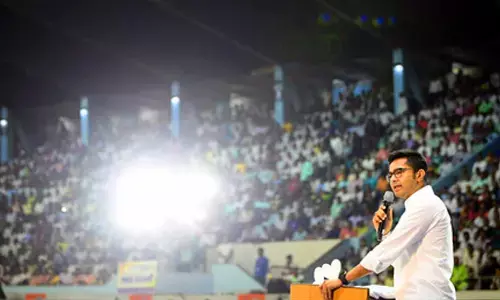Tackling problems of tribals

 Two issues demand study in regard to handling of tribals living in jungles literally over mines rich in precious ores. In the matter of ores, is it right for the government to drive them out of their ancestral and ancient homes so that forest land can be taken over not just for accessing ore but for making profits as well? Which is more important, the lives of tribals or meeting the needs of industry? Issue Two: what are morally right, letting tribals live their lives as they have lived for centuries or destroy their culture, drive them into urban areas to make a living so that the country at large can benefit? The same problem had arisen once in the United States when the white man was attempting to drive the Red Indians out of their homelands to the great suffering of the natives, way back in the 18th century and after. This is being replicated today in India in a different context. The Communists (Marxist-Leninist), long pushed out of urban centres with strikes getting out-of-date and labour unions a thing of the past, found in the trials and tribulation of the tribals a golden opportunity to make their presence felt. The way the tribals were being unceremoniously eased out of their homes gave the communists a moral cause to uphold and an equal chance to resurrect a dying ideology. Out of this was born Naxalism, more accurately described as Maoism rooted in ruthless violence at all costs. Mao, like Stalin before him, was guilty of killing millions of his own countrymen in promoting an evil ideology. If tribals had a problem, one way to resolve it could have been the Gandhian technique of satyagraha that had proved itself fairly successful in the 1930s in Bihar as well as in Gujarat. But tell that to communists and our pseudo-intellectuals. To them Gandhi is a huge joke, and Gandhism an outmoded means to achieve a noble end. Violence has its attraction with wholesale murder giving the communists a sense of glory. Non-violent plea for justice has no place in their muddled thinking. Naxalism had a beginning way back in 1967 and since then spread like wild fire in areas where tribals form a substantial percentage of the total population. In 2009 Naxalites were active approximately in 180 districts in 10 States. In August 2010, after the first full year of implementation of the National Tribal Policy (NTP), the number of Naxal-affected areas lessened to 83 districts across nine States. In December 2011, the Central Government reported that the number of Naxalite-related deaths had come down by nearly 50 percent from 2010 levels. Obviously the NTP is functioning reasonably well. Naxalites are the strongest in Chhattisgarh where, in just 2006, some 114 of them were killed. Andhra Pradesh came second with 108 killed. Ramachandra Guha, a well-known Human Rights activist, blames the Chhattisgarh government for the influence wielded by the Maoists. According to him, on the one side it granted a slew of leases to top industrialists, overriding protests of gram panchayats and handing over 'large tracts' of tribal land to mining companies. On the other side it promoted, says Guha, a 'vigilant army' � Salwa Judum, which distributed guns to young men owing allegiance to Mahendra Karma. Guha calls them 'goons' who roamed the countryside in search of Naxalites, real or fictitious, burning homes, sometimes entire villages, raping women and looting granaries, driving an estimated 150,000 adivasis out of their native villages, and , in the process, giving an ideological excuse to Naxalites to resort to more violence in revenge. Karma had set up the Salwa Judum which, in 2006, reportedly killed 114 alleged Maoists in Chhattisgarh and 108 in Andhra Pradesh. In return the Maoists killed 57 security forces and 192 civilians, also in Chhattisgarh, making a total of 249 killed in the same year. The Maoists are supposedly well-equipped with arms. In 2004, according to a Home Ministry report, there were in India 9,300 hard-core Maoists holding around 6,500 regular weapons, beside a large number of unlicensed country-made arms. How and where they got them from is another story that involves the ISI. In 2006, the strength of the movement rose to 15,000 with the guerillas controlling an estimated one fifths of Indian forests and being active in 160 of the nation's 604 administrative districts. That this number has since come down by 2011 is another matter. The Maoists are utterly unprincipled and in their effort to raise their strength they have targeted schools, school teachers, police stations, etc, to frighten people into submission. Maoists are opposed to development schemes as that would directly undo their cause. What they reportedly have in mind, stupid as it may sound, is to 'conquer' all of India! To fight them in 2006 the Central Government deployed about 37,000 security forces in Chhattisgarh alone and 30 companies in Jharkhand, two of the States where the Maoists are well-established. The Ministry of Home Affairs has allegedly allocated an annual budget of Rs 23,000 crore to address the Naxal conflict. It is clear that with increasing prosperity, despite pretty hard conditions noticeable in Chhattisgarh, Jharkhand and Bihar still noticeable, Naxalism seems to be on the decline which may explain their recent efforts to make news. If there is one national organization that can be of immense help, it is the RSS whose help the government must seek, setting aside irrelevant prejudices. But what can one expect of a UPA government which, after nine years in power has not been able to meet the authorized strength of 6,217 IAS officers, running a shortfall of 1,500? Naxalism is not for handling only by the government. It is an enemy of the country and the entire country must be recruited to fight the menace. And that calls for not just wisdom but high statesmanship. Ramachandra Guha, a well-known Human Rights activist, blames the Chhattisgarh government for the influence wielded by the Maoists
Two issues demand study in regard to handling of tribals living in jungles literally over mines rich in precious ores. In the matter of ores, is it right for the government to drive them out of their ancestral and ancient homes so that forest land can be taken over not just for accessing ore but for making profits as well? Which is more important, the lives of tribals or meeting the needs of industry? Issue Two: what are morally right, letting tribals live their lives as they have lived for centuries or destroy their culture, drive them into urban areas to make a living so that the country at large can benefit? The same problem had arisen once in the United States when the white man was attempting to drive the Red Indians out of their homelands to the great suffering of the natives, way back in the 18th century and after. This is being replicated today in India in a different context. The Communists (Marxist-Leninist), long pushed out of urban centres with strikes getting out-of-date and labour unions a thing of the past, found in the trials and tribulation of the tribals a golden opportunity to make their presence felt. The way the tribals were being unceremoniously eased out of their homes gave the communists a moral cause to uphold and an equal chance to resurrect a dying ideology. Out of this was born Naxalism, more accurately described as Maoism rooted in ruthless violence at all costs. Mao, like Stalin before him, was guilty of killing millions of his own countrymen in promoting an evil ideology. If tribals had a problem, one way to resolve it could have been the Gandhian technique of satyagraha that had proved itself fairly successful in the 1930s in Bihar as well as in Gujarat. But tell that to communists and our pseudo-intellectuals. To them Gandhi is a huge joke, and Gandhism an outmoded means to achieve a noble end. Violence has its attraction with wholesale murder giving the communists a sense of glory. Non-violent plea for justice has no place in their muddled thinking. Naxalism had a beginning way back in 1967 and since then spread like wild fire in areas where tribals form a substantial percentage of the total population. In 2009 Naxalites were active approximately in 180 districts in 10 States. In August 2010, after the first full year of implementation of the National Tribal Policy (NTP), the number of Naxal-affected areas lessened to 83 districts across nine States. In December 2011, the Central Government reported that the number of Naxalite-related deaths had come down by nearly 50 percent from 2010 levels. Obviously the NTP is functioning reasonably well. Naxalites are the strongest in Chhattisgarh where, in just 2006, some 114 of them were killed. Andhra Pradesh came second with 108 killed. Ramachandra Guha, a well-known Human Rights activist, blames the Chhattisgarh government for the influence wielded by the Maoists. According to him, on the one side it granted a slew of leases to top industrialists, overriding protests of gram panchayats and handing over 'large tracts' of tribal land to mining companies. On the other side it promoted, says Guha, a 'vigilant army' � Salwa Judum, which distributed guns to young men owing allegiance to Mahendra Karma. Guha calls them 'goons' who roamed the countryside in search of Naxalites, real or fictitious, burning homes, sometimes entire villages, raping women and looting granaries, driving an estimated 150,000 adivasis out of their native villages, and , in the process, giving an ideological excuse to Naxalites to resort to more violence in revenge. Karma had set up the Salwa Judum which, in 2006, reportedly killed 114 alleged Maoists in Chhattisgarh and 108 in Andhra Pradesh. In return the Maoists killed 57 security forces and 192 civilians, also in Chhattisgarh, making a total of 249 killed in the same year. The Maoists are supposedly well-equipped with arms. In 2004, according to a Home Ministry report, there were in India 9,300 hard-core Maoists holding around 6,500 regular weapons, beside a large number of unlicensed country-made arms. How and where they got them from is another story that involves the ISI. In 2006, the strength of the movement rose to 15,000 with the guerillas controlling an estimated one fifths of Indian forests and being active in 160 of the nation's 604 administrative districts. That this number has since come down by 2011 is another matter. The Maoists are utterly unprincipled and in their effort to raise their strength they have targeted schools, school teachers, police stations, etc, to frighten people into submission. Maoists are opposed to development schemes as that would directly undo their cause. What they reportedly have in mind, stupid as it may sound, is to 'conquer' all of India! To fight them in 2006 the Central Government deployed about 37,000 security forces in Chhattisgarh alone and 30 companies in Jharkhand, two of the States where the Maoists are well-established. The Ministry of Home Affairs has allegedly allocated an annual budget of Rs 23,000 crore to address the Naxal conflict. It is clear that with increasing prosperity, despite pretty hard conditions noticeable in Chhattisgarh, Jharkhand and Bihar still noticeable, Naxalism seems to be on the decline which may explain their recent efforts to make news. If there is one national organization that can be of immense help, it is the RSS whose help the government must seek, setting aside irrelevant prejudices. But what can one expect of a UPA government which, after nine years in power has not been able to meet the authorized strength of 6,217 IAS officers, running a shortfall of 1,500? Naxalism is not for handling only by the government. It is an enemy of the country and the entire country must be recruited to fight the menace. And that calls for not just wisdom but high statesmanship. Ramachandra Guha, a well-known Human Rights activist, blames the Chhattisgarh government for the influence wielded by the MaoistsNext Story















